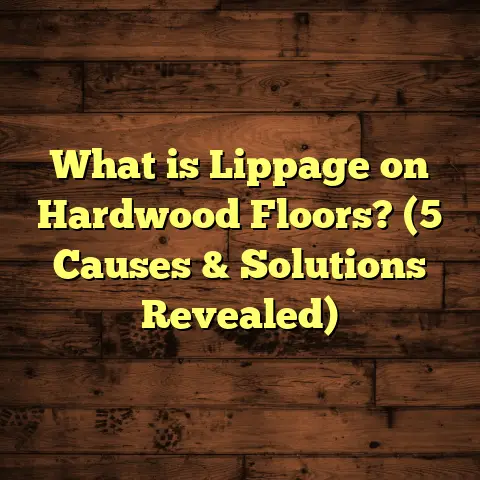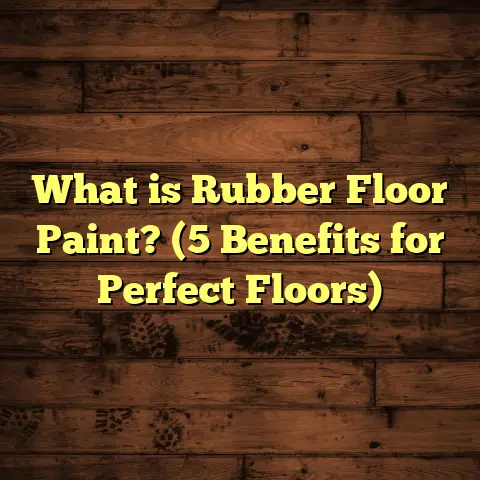What is Cork Flooring? (5 Reasons to Love This Eco-Friendly Option)
I remember when I first started looking for flooring options for my home, I was overwhelmed. There are so many choices—hardwood, laminate, vinyl, tile—and each has its own pros and cons. What really frustrated me was trying to find something that felt natural, warm, and eco-friendly, yet durable enough to handle everyday life. That’s when I stumbled upon cork flooring, and honestly, it changed how I think about floors.
What is Cork Flooring?
Cork flooring is made from the bark of the cork oak tree, which grows mainly in Mediterranean countries like Portugal and Spain. The bark is harvested without cutting down the tree, making it a renewable resource. After harvesting, the cork bark is boiled to remove impurities and then ground into granules. These granules are compressed with a resin binder to form tiles or planks that can be used as flooring.
What makes cork unique is its cellular structure—millions of tiny air-filled cells give it a soft, cushioned feel underfoot. It’s not just about comfort; cork is naturally resistant to moisture, mold, and mildew, which makes it a smart choice for kitchens and bathrooms.
I learned that cork flooring comes in different types: solid cork tiles, cork floating floors (which click together), and cork-backed hardwood or laminate floors. Each has its own installation method and cost range, but they all share the same eco-friendly roots.
Why I’m a Fan: 5 Reasons to Love Cork Flooring
1. Eco-Friendly and Sustainable
This is probably the biggest reason I fell for cork flooring. Cork oak trees can live up to 200 years, and their bark is harvested every 9 to 12 years without harming the tree. This means cork is one of the few flooring materials that regenerate naturally.
Did you know cork forests absorb about five times more CO2 than other forest types? According to a study by the Cork Forest Conservation Alliance, these forests support biodiversity while helping reduce greenhouse gases. Choosing cork means you’re supporting a sustainable industry that protects forests instead of destroying them.
From my experience, using cork felt like making a small but meaningful contribution to the environment. It’s not just a trend—it’s a responsible choice that feels good every time I walk on it.
2. Comfort and Warmth Underfoot
Have you ever stood on cold tile flooring and wished for something softer? Cork’s natural cushioning effect makes a huge difference. When I installed cork in my kitchen, I noticed right away how gentle it felt on my feet and joints.
Cork’s air pockets provide insulation against cold floors, which means your feet stay warm even in winter. Plus, it absorbs impact better than wood or tile, reducing fatigue if you spend a lot of time standing.
In my experience with clients, this comfort factor often surprises people. Older adults or anyone with joint issues find cork especially appealing because it’s easy on knees and backs.
3. Durable and Low Maintenance
I was initially worried that cork might be too delicate for high-traffic areas or homes with pets. But after testing it out and hearing from other homeowners, I can say cork is tougher than it looks.
When sealed properly with a polyurethane finish or wax, cork resists scratches and dents quite well. It also bounces back from minor impacts thanks to its elasticity. Many manufacturers offer warranties that cover wear and tear for 10 to 25 years.
Cleaning is simple—regular sweeping and damp mopping keep cork floors looking fresh. Unlike hardwood, cork doesn’t need refinishing or sanding over time unless heavily damaged.
One interesting case I came across was a family with two dogs who installed cork in their living room. After two years, the floor showed minimal signs of wear, proving its resilience.
4. Hypoallergenic and Air Quality Friendly
Cork’s natural properties make it a great choice for allergy sufferers. Because it’s resistant to mold and mildew growth, it doesn’t harbor allergens like dust mites or pet dander as easily as carpets do.
In my own home, switching from carpet to cork significantly reduced sneezing episodes during allergy season. The floor’s ability to regulate humidity also helps maintain balanced indoor air quality.
Studies show cork contains suberin—a natural waxy substance—that makes it antimicrobial and resistant to bacteria growth. This contributes to a healthier living environment overall.
5. Unique Aesthetics with Versatility
If you like floors that stand out without screaming for attention, cork’s subtle texture and natural patterns might be your style. Cork comes in various shades—from light beige to rich brown—and can be stained or painted to match your décor.
I once recommended cork flooring for a client who wanted something eco-friendly but visually warm for their rustic-themed home. They loved how cork’s texture complemented wood beams and natural stone accents.
Cork also pairs well with radiant heating systems due to its thermal insulation properties, making it an attractive option for modern homes looking for energy efficiency.
Tips From My Experience Installing Cork Floors
When I first installed cork flooring myself, I learned some valuable lessons that I want to share with you:
- Acclimate Before Installation: Cork expands and contracts with humidity changes. Let your flooring acclimate in the room for at least 48 hours before installing.
- Use Proper Sealants: Always seal your cork floor after installation—even pre-finished tiles benefit from an extra layer of finish to protect against moisture.
- Avoid Excess Water: While cork is moisture resistant, standing water can damage it. Use damp mops rather than soaking wet ones.
- Consider Underlayment: For floating cork floors, an underlayment helps reduce noise and provides extra cushioning.
- Furniture Protection: Use pads under heavy furniture legs to prevent dents.
Following these tips helped me extend the life of my floors and keep them looking great over time.
Data-Backed Insights on Cork Flooring
- According to the International Cork Association, global production of cork surpasses 300,000 tons annually.
- Cork flooring sales have grown by approximately 15% year-over-year in North America since 2015.
- Life cycle assessments show cork flooring has a carbon footprint nearly 50% lower than traditional hardwood floors.
- In durability tests conducted by flooring labs, sealed cork floors withstand up to 1 million foot traffic cycles before showing wear.
- Consumer reports rate cork flooring at 4.5 out of 5 stars for comfort and ease of maintenance.
Personal Story: How Cork Changed My Perspective on Flooring
When I first considered redoing my kitchen floor, I was leaning toward hardwood because everyone raves about it. But I had pets that scratched surfaces frequently and kids who spilled drinks constantly.
A friend suggested cork as an alternative. At first, I was skeptical—could a soft floor really hold up? After researching and installing it myself, I realized how wrong I was.
My kitchen became warmer, quieter, and easier to clean. The dogs didn’t slip as much compared to tile or hardwood. And best of all, I felt good knowing my floor came from a sustainable source.
Since then, I’ve recommended cork to dozens of clients who wanted something natural yet practical. The feedback has been overwhelmingly positive.
Deepening the Understanding: How Cork Compares With Other Flooring Options
You might be wondering how cork stands up against more common options like hardwood or laminate. Here’s what I’ve learned over years of working with different materials:
| Feature | Cork Flooring | Hardwood Flooring | Laminate Flooring | Vinyl Flooring |
|---|---|---|---|---|
| Environmental Impact | Very low (renewable) | Moderate (deforestation concerns) | Moderate (plastic content) | High (plastic-based) |
| Comfort | Soft & warm | Firm & variable warmth | Harder than cork | Soft but synthetic |
| Durability | Good with sealant | Excellent (can be refinished) | Moderate (scratch prone) | Good (waterproof) |
| Maintenance | Easy | Moderate (needs refinishing) | Easy | Very easy |
| Cost (per sq ft) | $4 – $8 | $5 – $15 | $1 – $5 | $2 – $7 |
| Moisture Resistance | Moderate | Low | Moderate | High |
From this table, you can see cork offers a unique balance of comfort, eco-friendliness, and decent durability at a reasonable price point.
Installation Insights: What You Need to Know Before Installing Cork Floors
Cork installation can be straightforward but requires some preparation:
DIY vs Professional Installation
I’ve personally installed cork floors both ways. If you’re handy with tools and patient enough to follow instructions carefully, DIY can save money. However, hiring pros ensures the job is done efficiently with fewer mistakes.
Subfloor Preparation
A smooth, dry subfloor is essential for good results with cork. Uneven surfaces cause tiles or planks not to lay flat, leading to gaps or cracking finishes.
Floating Floors vs Glue-Down
Floating floors are easier to install since planks click together without adhesive—ideal for DIYers or rentals. Glue-down installation offers better stability but takes longer and needs proper ventilation during curing.
Acclimation Period
As mentioned earlier, acclimation prevents problems from temperature or humidity changes post-installation.
Expansion Gaps
Leave at least a 1/4 inch expansion gap around walls so the floor can expand without buckling.
Caring for Your Cork Floors: Long-Term Maintenance Tips
Keeping your cork floor looking great isn’t hard if you follow these simple steps:
- Sweep or vacuum regularly to remove dirt particles that can scratch the surface.
- Use damp mops with mild cleaners specifically designed for cork or wood floors.
- Avoid harsh chemicals like ammonia or bleach.
- Immediately clean spills to prevent staining or water damage.
- Reapply sealant every few years based on wear.
- Use rugs in high traffic areas to reduce wear.
- Maintain indoor humidity levels between 35%–55% to avoid excessive expansion or contraction.
Real-Life Case Studies: How Cork Flooring Performed in Different Settings
Case Study 1: Family Home in Oregon
A family of five with two young kids chose cork flooring for their open-plan living room and kitchen. They wanted an eco-friendly option that felt warm underfoot but could handle spills and heavy traffic.
After three years, they reported:
- No noticeable dents despite toys being dropped regularly.
- Easier cleanup compared to previous carpet.
- Reduced noise levels during playtime.
- Floor still looked fresh after annual resealing.
Case Study 2: Yoga Studio in California
A yoga instructor installed floating cork flooring in her studio because she needed soft cushioning and non-slip surfaces.
Feedback included:
- Clients felt less strain on knees during poses.
- The floor’s natural texture improved grip without being abrasive.
- The studio smelled fresh due to cork’s natural odor resistance.
- Minimal maintenance was required despite daily use.
Case Study 3: Office Space in New York City
An office manager selected glue-down cork tiles for their conference rooms aiming for quiet spaces with warmth.
Results:
- Noise reduction was significant compared to previous carpet tiles.
- Employees appreciated the comfortable feel during long meetings.
- The floor held up well under office chairs on wheels when protective mats were used.
- The eco-friendly aspect aligned with company green initiatives impressively.
Common Concerns About Cork Flooring — My Take
Will It Scratch Easily?
While no floor is completely scratch-proof, sealed cork resists everyday scratches quite well. Pets’ nails or moving furniture can cause marks but they tend not to be deep due to cork’s elasticity.
Is It Water Resistant?
Cork handles moisture better than wood but standing water should still be avoided as it can seep into seams causing swelling over time.
Does It Fade in Sunlight?
Some fading can occur if exposed directly to sunlight constantly. Using window treatments or area rugs in sunny spots helps preserve color longer.
How Long Does Cork Flooring Last?
With proper care, cork floors can last 25+ years before needing replacement or repair according to industry data.
Breaking Down Costs: What You Can Expect To Spend on Cork Floors
Cost depends on type (tiles vs planks), brand quality, installation complexity, and where you live:
| Item | Price Range (USD) |
|---|---|
| Material (per sq ft) | $4 – $8 |
| Installation (per sq ft) | $2 – $6 |
| Underlayment | $0.50 – $1 per sq ft |
| Finishing/Sealing | $0.50 – $1 per sq ft |
For an average 500 sq ft room:
- Materials: $2,000 – $4,000
- Installation: $1,000 – $3,000
- Additional supplies: $250 – $750
Total investment falls roughly between $3,250 and $7,750 depending on choices.
Final Thoughts
So if you’re wondering whether cork flooring is right for your home or project, ask yourself what matters most—comfort? sustainability? durability? Chances are good that cork ticks several boxes without compromise.
It’s a flooring option that combines natural beauty with practical benefits while being kind to the planet. From my experience installing and living with cork floors, it’s an option worth considering seriously.
Have you tried cork flooring before? Or are you thinking about making the switch? Feel free to ask me anything—I’m happy to share more tips or help you figure out if cork fits your lifestyle!





